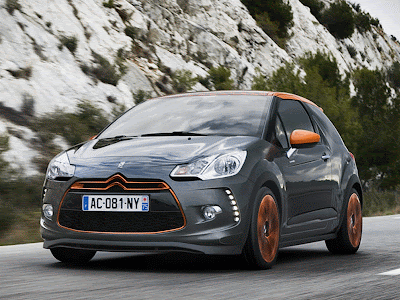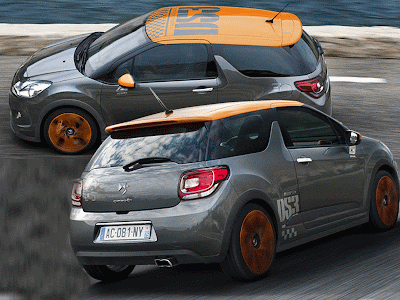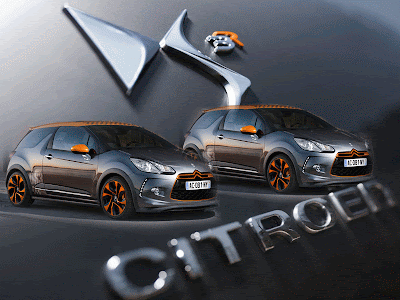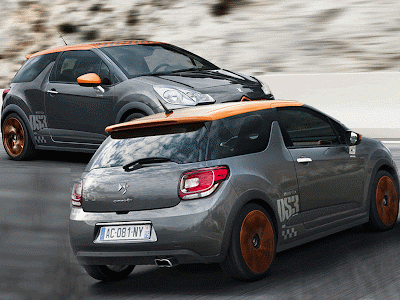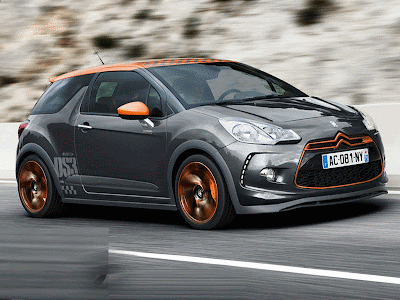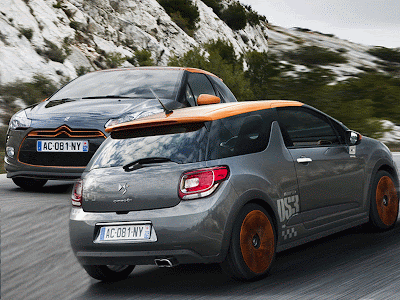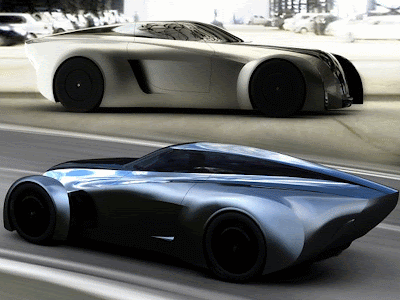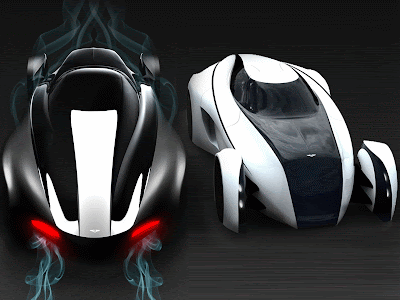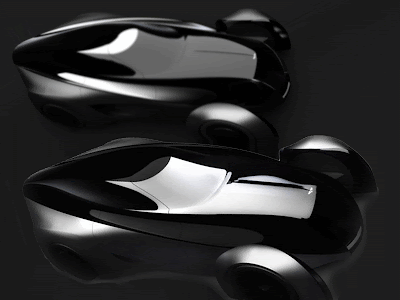From the Manchester Evening News:
"... Mark Halasi, who sets the tone with an exciting act involving twisting around in a large hammock up in the roof of the tent."
Isn't it nice?
2010 Citroen DS3 Racing Car Limited Edition
Citroen plans to unveil a limited edition of the Citroen DS3 next month at the Geneva Motor Show. The Citroen DS3 Racing is a suped up version of the company's luxe supermini. While only 1000 units will be built, Citroen Australia General Manager, Miles Williams said that local availability for the special DS3 Racing will be announced when the regular DS3 launches in August.
2010 Citroen DS3 Racing Car Limited Edition
“The Citroen DS3 Racing represents an outstanding concentration of behind-the-wheel thrills with an artful blend of performance and efficiency. The DS3 Racing provides a clear indication of what we can expect when the DS3 arrives in Australia in August.” Mr Williams said.
2010 Citroen DS3 Racing Car Limited Edition
Developed by Citroën Racing - the winning team behind five WRC manufacturer's titles and six driver's titles for Sébastien Loeb and Daniel Elena - Citroën DS3 Racing is a special edition with a 100% sporting pedigree. Planned for the second half of 2010, the exclusive Citroën DS3 Racing will be limited to just 1000 production units.
2010 Citroen DS3 Racing Car Limited Edition
As such, the car's output has been bumped up by 30% to 200 PS (147 kW / 197 hp) using the turbocharged 1.6-liter THP engine. Torque is improved by 15% to 275 Nm (203 lb-ft). These changes were achieved by remapping the engine control unit, adjusting the turbo, and adjusting powertrain components.
2010 Citroen DS3 Racing Car Limited Edition
Meanwhile, stiffer suspension springs and new shock absorbers are also installed. The car has been lowered by 15mm, while both the front and rear track were widened by 30mm. Along with the new tires wrapped around the 18-inch wheels, the changes "all dramatically change the driving dynamics," according to a press release.
2010 Citroen DS3 Racing Car Limited Edition
To handle the extra power, the company installed four-piston caliper brakes up front and ventillated discs in back. Carbon-fiber touches are used on the new air diffuser, front bumper, lower body, and wing extensions. Chrome is also used at certain points, like the door handles and exhaust, with orange tint on the calipers, grille, roof, side mirror caps, and wheels. Inside, designers added carbon trim and orange inserts. Purposeful sport seats were also installed.
A Citroën DS3 Racing signature on the rear tailgate and an individually numbered identification plate fixed to the roof-lining further confirm the model's exclusivity.
2010 Citroen DS3 Racing Car Limited Edition
At 3.94-meters long, the grey and orange car will be shown in Geneva with checkered flaq and DS3 Racing graphics. Based on the existing DSport powered by the THP 150, production Citroën DS3 Racing editions will be finished in a special workshop and fitted with a parts kit developed according to Citroën Racing specifications. Only 1000 units of the Citroen DS3 Racing will be produced. The car will be released in the second half of 2010.
2010 Opel Flextreme GT/E Concept with E-REV Drive System
Think of the Opel Flextreme GT/E concept as a bigger Chevrolet Volt (or Opel Ampera if you're European). The idea behind this concept, which will debut at the Geneva Motor Show (March 4 - 14, 2010), is to show how the Volt's extended-range electric vehicle drivetrain can be used in a larger vehicle, in this case a mid-size five-door hatchback. And it will boost the company's credentials as a leader in green technologies, offering expressive design with efficient environmental performance - and engineered with German precision.
2010 Opel Flextreme GT/E Concept with E-REV Drive System
In Opel's strategy for achieving more independence from fossil fuels, electricity plays a key role. The 4.7-meter long Opel Flextreme GT/E Concept illustrates how extended-range electric vehicle (E-REV) technology can be plugged into large or mid-size vehicles, as well as compact cars such as the upcoming Opel Ampera. Opel calls this strategy e-mobility unlimited: adapting the highly efficient E-REV drive system - which removes the limitations of battery-only power - to vehicles across all market segments. To enjoy zero CO2 driving emissions Opel-style, the Flextreme GT/E concept shows that size doesn't matter.
2010 Opel Flextreme GT/E Concept with E-REV Drive System
The purposeful design also enables the Opel Flextreme GT/E Concept to achieve a projected drag co-efficient of just 0.22, which helps it reach a 200 km/h-plus top speed as well as conserve energy and extend its driving range. Stand-out visual features include a low and wide stance, wing-shaped lights front and rear, a distinctive nose and grille, floating C-pillars and muscular, sculptured bodywork.
2010 Opel Flextreme GT/E Concept with E-REV Drive System
The clean, frontal styling features a low hood line and an extended nose section, which is clasped by wing-shaped, signature LED headlamps. These are deeply carved into the front fenders and across the hood line. The new trapezoidal grille execution is slim but bold. The prominent wing-shaped chrome bar carries a large Opel emblem, which doubles as a socket for charging the Opel Flextreme GT/E Concept's battery pack. The upper section of the grille is used to admit cooling air, the lower portion being covered by a translucent panel. The absence of additional air intakes allows a low frontal area for aerodynamic efficiency and also enables the Opel Flextreme GT/E Concept to meet future pedestrian protection requirements.
2010 Opel Flextreme GT/E Concept with E-REV Drive System
In profile, the Opel Flextreme GT/E Concept is distinguished by innovative, stubbed C-pillars. This floating design allows the glasshouse to be extended rearwards under the arching roofline, emphasizing the flowing lines of the side body. The car's dynamic character is further underlined by a fresh expression of Opel's signature blade motif, now a swooping swage line from the base of the C-pillar into the lower front fender. The translucency of the fixed glass panel in the center of the roof is adaptive, allowing sunlight to warm the interior in the cold of winter, but darkening for coolness in summer. A duct at the rear edge of the roof is for additional cooling of the battery and electronic components.
2010 Opel Flextreme GT/E Concept with E-REV Drive System
Integral to the Opel Flextreme GT/E Concept's expressive looks is the efficiency of the design execution. The small frontal area, low roof height (1308 mm) and a flat, enclosed underbody all enable the car to cleave the air with a minimum of disturbance. The 21-inch alloy wheels are relatively narrow, to reduce wind resistance, and fitted with 195/45, low rolling resistance tires. Clear, flush-mounted trim inserts also minimize air turbulence.
2010 Opel Flextreme GT/E Concept with E-REV Drive System
The Opel Flextreme GT/E Concept also explores the potential for active shape shifting. At speeds above 50 km/h, a vertical panel extends along the body from the air extraction slot behind each rear wheel-arch. These 350 mm-long side spoilers guide high-speed airflow around the rear corners of the car, further reducing the amount of turbulence.
2010 Opel Flextreme GT/E Concept with E-REV Drive System
Mass reduction measures for the body include the use of lightweight, carbon composite outer panels, polycarbonate window glazing and aluminum alloy structural components. Compared to conventional materials, these offer a 40 percent weight saving which further contributes to reduced energy consumption and an increased driving range.
The efficient concept also includes GM's ground-breaking E-REV drive system, already developed for the Opel Ampera. The Opel Flextreme GT/E Concept shows the versatility of this technology by displaying it in a larger, mid-size vehicle format.
2010 Opel Flextreme GT/E Concept with E-REV Drive System
Despite its greater size and a maximum speed of more than 200 kilometers per hour, the Opel Flextreme GT/E Concept is projected to offer performance similar to that of the Ampera: a battery-powered driving range of up to 60 km - with zero CO2 tailpipe emissions - and a total range of more than 500 km. Average fuel consumption is estimated at 1.6 l/100 km, with CO2 emissions of less than 40 g/km. Unlike a hybrid vehicle, the wheels of the Opel Flextreme GT/E Concept are powered at all times by electricity. For typical journeys up to 60 km, energy is supplied by a T-shaped lithium-ion battery pack located under the floor and rear seat.
2010 Opel Flextreme GT/E Concept with E-REV Drive System
However, unlike a battery-only electric vehicle, the Opel Flextreme GT/E Concept eliminates any possibility of range anxiety through fear of being stranded without power. The small gasoline engine/generator is seamlessly engaged to provide electricity whenever the battery's supply becomes depleted. In this mode, the driving range is extended to more than 500 km, until the plug-in battery pack can be recharged or the car is refueled. The motor in the electric drive unit delivers a substantial 370 Nm of instant torque, giving lively performance and projected zero to 100 km/h acceleration in less than nine seconds.
2010 Opel Flextreme GT/E Concept with E-REV Drive System
The Flextreme GT/E concept is a further step in Opel's unfolding strategy for the electrification of the automobile, which includes a wide portfolio of products using battery, extended-range, hybrid and fuel cell technologies.
Bentley AERO ACE Sports Car Concept Next-Gen Speed VI
The Bentley Aero Ace Speed VI is the brainchild of auto designer Gabriel Tam and has been inspired by the original Speed 6 driven to victory by the Bentley Boys of the ’20s at Le Mans. The next-generation Speed VI is an overtly sporting vehicle with the raw aggression of a pure blood racer, while retaining the refined elegance of past Bentleys.
Bentley AERO ACE Electric Sports Car Concept Next-Gen Speed VI
The design was inspired to signify the raw aggression of a sporting vehicle, while paying close attention to the aerodynamic properties of each element of the vehicle. The adjustable aerofoil / spoiler feature double wishbone suspension to maximize the efficiency.
Bentley AERO ACE Electric Sports Car Concept Next-Gen Speed VI
Close attention during the designing period to refine the aerodynamic properties of the vehicle has resulted in enhanced efficiency and increased speed. Additionally, a double wishbone suspension has been incorporated within the adjustable spoiler to further better its efficiency.
Bentley AERO ACE Electric Sports Car Concept Next-Gen Speed VI
The twin rear heat exhaust-ducts of this zero-emission concept car are fed by the air intake used to keep electric motors cool. Electric motors are located towards the rear of the vehicle, while the battery cells are located towards the front in an even arrangement to balance the weight. The electric motor cooling system features air intake and incorporates diffusers that help air flow to create down-force.
Bentley AERO ACE Electric Sports Car Concept Next-Gen Speed VI
The wheels are semi enclosed that improves aerodynamics, while the 1+1 seating arrangement offers focused driving experience. Also, the diffusers aid air flow in this vehicle creates the down-force, the battery pack is equally distributed and the vehicle has a 1+1 seating layout for finest weight distribution.
Bentley AERO ACE Electric Sports Car Concept Next-Gen Speed VI
Fotos do novo “avião” da Pagani, o Zonda Tricolore
 O mais novo superesportivo da Pagani chama-se Zonda Tricolore. Ele foi inspirado Força Aérea Italiana, que comemora 50 anos.
O mais novo superesportivo da Pagani chama-se Zonda Tricolore. Ele foi inspirado Força Aérea Italiana, que comemora 50 anos.Trata-se de uma Edição especial limitadíssima, pois somente há um exemplar que é derivado do já exclusivo Zonda Cinque e custará a bagatela de 1,3 milhões de euros.
O Tricolore vem com a carroçaria em fibra de carbono pintada, parcialmente, a azul e decorada com as cores da bandeira italiana verde, branco e vermelho. As entradas de ar de maiores dimensões e as luzes diurnas em LED são dos detalhes que o diferem do Zonda Cinque. No interior ele destaca a fibra de carbono e revestimento em couro na cor azul.
O Pagani Zonda Tricolore será apresentado ao público no Salão de Genebra, no próximo dia 4 de março.
Clique nas fotos para ampliar









Commute-20f, warm, sunny

I am so optimistic about Spring. As I walked to the office today, I heard more birds singing their songs. 20f warm? I know, but being in the cold everyday and the fact the last two days were in the single digits, yes, 20f is warm.
I do need green!
Chevrolet CORVETTE Racing at Sebring 2010
Back in August when General Motors introduced the all-new GT2 class Corvette C6.R, it ran downsized 6.0-liter version of the 7.0-liter V8 from the long-dominant GT1 car. At the launch, Corvette Racing program manager Doug Fehan told us the 6.0-liter was just an interim engine. With revised GT rules on tap for 2010, GM was already planning a brand-new engine for its race Vette.
Chevrolet CORVETTE Racing at Sebring 2010
Unlike the 6.0/7.0, which is a ground-up race engine that only shares basic architectural dimensions with the production small block, the 2010 C6.R's V8 is a new 5.5-liter unit that will indeed be derived from the production engine found in roadgoing Corvettes. In fact, the 5.5-liter race engine will be built at GM's Performance Build Center alongside ZR1 and Z06 V8s.
Chevrolet CORVETTE Racing at Sebring 2010
Fehan has confirmed that the 5.5 is running on the dyno and will make its race debut at the 12 Hours of Sebring in March. We don't have any additional details on the new engine yet, although we were told earlier that it is based on the next-generation production small-block, which we expect to see in the Corvette soon
Chevrolet CORVETTE Racing at Sebring 2010
Corvette Racing is preparing for the season-opening round of the 2010 American Le Mans Series, the Mobil 1 Twelve Hours of Sebring, to be held in Sebring, Fla., on March 20. Forty years ago, Sebring set the stage for some highly competitive racing among Cobras, Ferraris, and Corvettes.
Chevrolet CORVETTE Racing at Sebring 2010
Difficult weather and trying mechanical situations added a challenging dimension to an exciting event. In light of recent C5-R successes and the impending start of yet another season of American Le Mans Series competition, a look back at the effort put forth by the privateer Corvette camp lends amazing perspective.
Chevrolet CORVETTE Racing at Sebring 2010
Corvette Racing will compete in the GT (formerly GT2) class against entries representing Porsche, Ferrari, BMW, Jaguar, and Ford. Corvette Racing drivers Johnny O'Connell, Jan Magnussen, and Antonio Garcia are testing the No. 3 Compuware Corvette C6.R. Oliver Gavin, Olivier Beretta, and Emmanuel Collard are testing the No. 4 Compuware Corvette C6.R.
[Source: Chevrolet]
Chevrolet CORVETTE Racing at Sebring 2010
Subscribe to:
Comments (Atom)

